Fatigue Behaviour and Its Effect on the Residual Strength of Long-Fibre-Reinforced Thermoplastic PP LGF30
Abstract
:1. Introduction
2. Modelling Residual Properties after Fatigue Damage
2.1. Determination of Fatigue Damage
2.2. Modelling of Residual Strength
3. Materials and Specimen Geometry
4. Experimental Methods
- -
- Static tensile tests on new specimens to determine the elastic moduli and strengths of the new material with different fibre orientations. All orientations will be repeated 3 times each.
- -
- Destructive cyclic tests to determine the damage progression and the orientation angle-dependent S–N curves, which represent the fatigue behaviour. Overall, 36 specimens are used.
- -
- Non-destructive cyclic tests on individual specimens prior to damage.
- -
- Static tensile tests on pre-damaged specimens for comparison with undamaged specimens and validation of models for predicting residual strength, with overall 13 specimens.
5. Results
5.1. Results of Static Testing
5.2. Results of Cyclic Testing
5.3. Inducing of Fatigue Damage into Specimens
5.4. Residual Strength of Pre-Damaged Specimens
6. Discussion
7. Summary and Conclusions
Author Contributions
Funding
Data Availability Statement
Acknowledgments
Conflicts of Interest
References
- Sayers, C.M. Elastic anisotropy of short-fibre reinforced composites. Int. J. Solids Struct. 1992, 29, 2933–2944. [Google Scholar] [CrossRef]
- Schmachtenberg, E.; Brandt, M. Mechanical Design of Injection Moulded Parts made of Short-Fibre Reinforced Thermoplastics by Means of Integrative Simulation. J. Polym. Eng. 2006, 26, 179–196. [Google Scholar] [CrossRef]
- McNally, D. Short Fiber orientation and its Effects on the Properties of Thermoplastic Composite Materials. Polym. Plast. Technol. Eng. 1977, 8, 101–154. [Google Scholar] [CrossRef]
- Pavšek, V. Zur Ermüdungsrissausbreitung bei Kurzglasfaserverstärkten Thermoplasten; Technisch-wissenschaftlicher Bericht/Demonstrationszentrum für Faserverbundwerkstoffe; Universität Erlangen Nürnberg Lehrstuhl für Kunststofftechnik: Erlangen, Germany, 1996. [Google Scholar]
- Witzgall, C.; Wartzack, S. Validation of an approach for the simulation of short fiber reinforced thermoplastics in early design phases. In Proceedings of the 26th Symposium Design for X, DFX 2015, Herrsching, Germany, 7–8 October 2015; pp. 63–74. [Google Scholar]
- Krivachy, R.; Riedel, W.; Weyer, S.; Thoma, K. Characterisation and modelling of short fibre reinforced polymers for numerical simulation of a crash. Int. J. Crashworthiness 2008, 13, 559–566. [Google Scholar] [CrossRef]
- Rouchon, J. Certification of large airplane composite structures. Recent progress and new trends in compliance philosophy. ICAS Congr. Proc. 1990, 2, 1439–1447. [Google Scholar]
- Yang, J.N.; Liu, M.D. Residual Strength Degradation Model and Theory of Periodic Proof Tests for Graphite/Epoxy Laminates. J. Compos. Mater. 1977, 11, 176–203. [Google Scholar] [CrossRef]
- Polzer, M.; Bartz, M.; Rothammer, B.; Schulz, E.; Wartzack, S. Tribological behavior of different doped ta-C coatings for slip-rolling contacts with high hertzian contact pressure. Ind. Lubr. Tribol. 2023, 75, 748–757. [Google Scholar] [CrossRef]
- Ning, H.; Lu, N.; Hassen, A.A.; Chawla, K.; Selim, M.; Pillay, S. A review of long fibre thermoplastic (LFT) composites. Int. Mater. Rev. 2020, 65, 164–188. [Google Scholar] [CrossRef]
- Markarian, J. Long fibre reinforced thermoplastics continue growth in automotive. Plast. Addit. Compd. 2007, 9, 20–24. [Google Scholar] [CrossRef]
- Kim, D.H.; Lee, Y.S.; Son, Y. Anomalous rheological behavior of long glass fiber reinforced polypropylene. Korea-Australia Rheol. J. 2012, 24, 307–312. [Google Scholar] [CrossRef]
- Witzgall, C.; Wartzack, S. An investigation of mechanically aged short-fiber reinforced thermoplastics under highly dynamic loads. In Proceedings of the 27th Symposium Design for X, DFX 2016, Jesteburg, Germany, 5–6 October 2016; Krause, D., Paetzold, K., Wartzack, S., Eds.; pp. 135–146. [Google Scholar]
- Witzgall, C.; Wartzack, S. Experimental and simulative assessment of crashworthiness of mechanically aged shortfibre reinforced thermoplastics. In Proceedings of the 21st International Conference on Engineering Design (ICED 17), Vancouver, Canada, 21–25 August 2017; pp. 279–287. [Google Scholar]
- Witzgall, C.; Huber, M.; Wartzack, S. Consideration of cyclic material degradation in the crash simulation of short-fibre-reinforced thermoplastics. Konstruktion 2020, 1–2, 78–82. [Google Scholar] [CrossRef]
- Reifsnider, K.L.; Henneke, E.G.; Stinchcomb, W.W.; Duke, J.C. Damage mechanics and Nde of composite laminates. In Mechanics of Composite Materials; Elsevier: Amsterdam, The Netherlands, 1983; pp. 399–420. [Google Scholar]
- Mao, H.; Mahadevan, S. Fatigue damage modelling of composite materials. Compos. Struct. 2002, 58, 405–410. [Google Scholar] [CrossRef]
- Nutini, M.; Vitali, M. Interactive failure criteria for glass fibre reinforced polypropylene: Validation on an industrial part. Int. J. Crashworthiness 2017, 24, 24–38. [Google Scholar] [CrossRef]
- Hill, R. A Theory of the Yielding and Plastic Flow of Anisotropic Metals. Proc. R. Soc. Lond. Ser. A Math. Phys. Sci. 1948, 193, 281–297. [Google Scholar] [CrossRef]
- Hill, R. The Mathematical Theory of Plasticity. Oxford Classic Texts in the Physical Sciences Nr. 11; Clarendon Press: Oxford, UK, 1998. [Google Scholar]
- Van Paepegem, W.; Degrieck, J. A new coupled approach of residual stiffness and strength for fatigue of fibre-reinforced composites. Int. J. Fatigue 2002, 24, 747–762. [Google Scholar] [CrossRef]
- Van Paepegem, W. Fatigue damage modelling of composite materials with the phenomenological residual stiffness approach. In Fatigue Life Prediction of Composites and Composite Structures; Elsevier: Amsterdam, The Netherlands, 2010; pp. 102–138. [Google Scholar]
- Witzgall, C.; Giolda, J.; Wartzack, S. A novel approach to incorporating previous fatigue damage into a failure model for short-fibre reinforced plastics. Int. J. Impact Eng. 2022, 18, 104155. [Google Scholar] [CrossRef]
- Shokrieh, M.M.; Lessard, L.B. Progressive Fatigue Damage Modeling of Composite Materials, Part I: Modeling. J. Compos. Mater. 2000, 34, 1056–1080. [Google Scholar] [CrossRef]
- Tseng, H.-C.; Goto, M.; Chang, R.-Y.; Hsu, C.-H. Accurate predictions of fiber orientation and mechanical properties in long-fiber-reinforced composite with experimental validation. Polym. Compos. 2018, 39, 3434–3445. [Google Scholar] [CrossRef]
- Becker, F.; Kolling, S.; Schöpfer, J. Material Data Determination and Crash Simulation of Fiber Reinforced Plastic Components. In Proceedings of the 8th European LS-DYNA Conference, Bamberg, Germany, 23–24 May 2011. [Google Scholar]
- Bernasconi, A.; Kulin, R.M. Effect of frequency upon fatigue strength of a short glass fiber reinforced polyamide 6: A superposition method based on cyclic creep parameters. Polym. Compos. 2009, 30, 154–161. [Google Scholar] [CrossRef]
- Fatemi, A.; Mortazavian, S.; Khosrovaneh, A. Fatigue Behavior and Predictive Modeling of Short Fiber Thermoplastic Composites. Procedia Eng. 2015, 133, 5–20. [Google Scholar] [CrossRef]
- Chu, T.C.; Ranson, W.F.; Sutton, M.A. Applications of digital-image-correlation techniques to experimental mechanics. Exp. Mech. 1985, 25, 232–244. [Google Scholar] [CrossRef]
- ISO 527-1:2012-06; Kunststoffe—Bestimmung der Zugeigenschaften—Teil 1: Allgemeine Grundsätze. Beuth: Berlin, Germany, 2012.
- DIN 50100:2016-12; Schwingfestigkeitsversuch—Durchführung und Auswertung von zyklischen Versuchen mit konstanter Lastamplitude für metallische Werkstoffproben und Bauteile. Beuth: Berlin, Germany, 2016.
- Martin, A.; Hinkelmann, K.; Esderts, A. Zur Auswertung von Schwingfestigkeitsversuchen im Zeitfestigkeitsbereich. Teil 1: Wie zuverlässig können 50%-Wöhlerlinien aus experimentellen Daten geschätzt werden? Mater. Test. 2011, 53, 502–512. [Google Scholar] [CrossRef]
- Varvani-Farahani, A.; Shirazi, A. A Fatigue Damage Model for (0/90) FRP Composites based on Stiffness Degradation of 0° and 90° Composite Plies. J. Reinf. Plast. Compos. 2007, 26, 1319–1336. [Google Scholar] [CrossRef]
- Varvani-Farahani, A.; Haftchenari, H.; Panbechi, M. A Fatigue Damage Parameter for Life Assessment of Off-axis Unidirectional GRP Composites. J. Compos. Mater. 2006, 40, 1659–1670. [Google Scholar] [CrossRef]
- Varvani-Farahani, A.; Haftchenari, H.; Panbechi, M. An energy-based fatigue damage parameter for off-axis unidirectional FRP composites. Compos. Struct. 2007, 79, 381–389. [Google Scholar] [CrossRef]
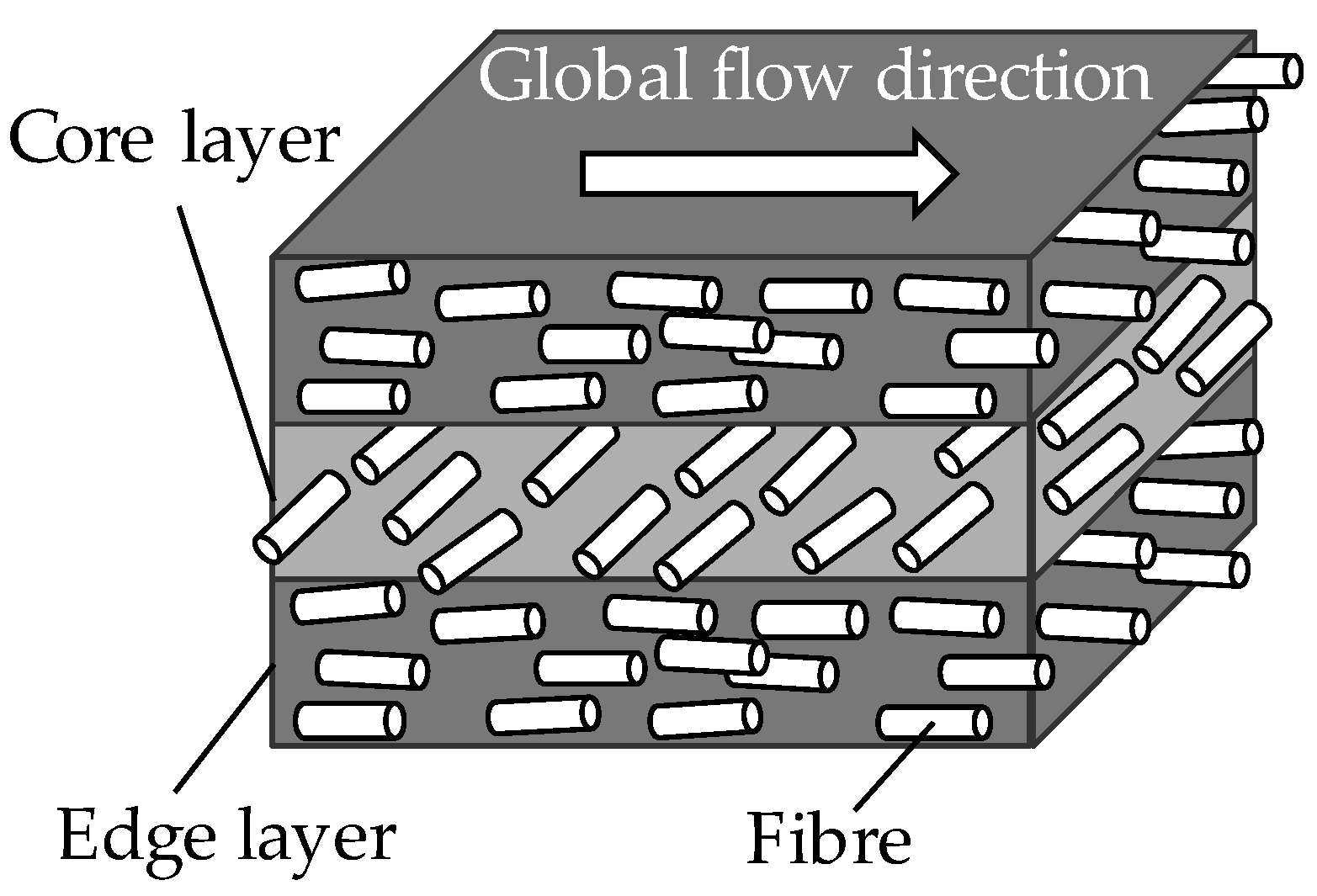
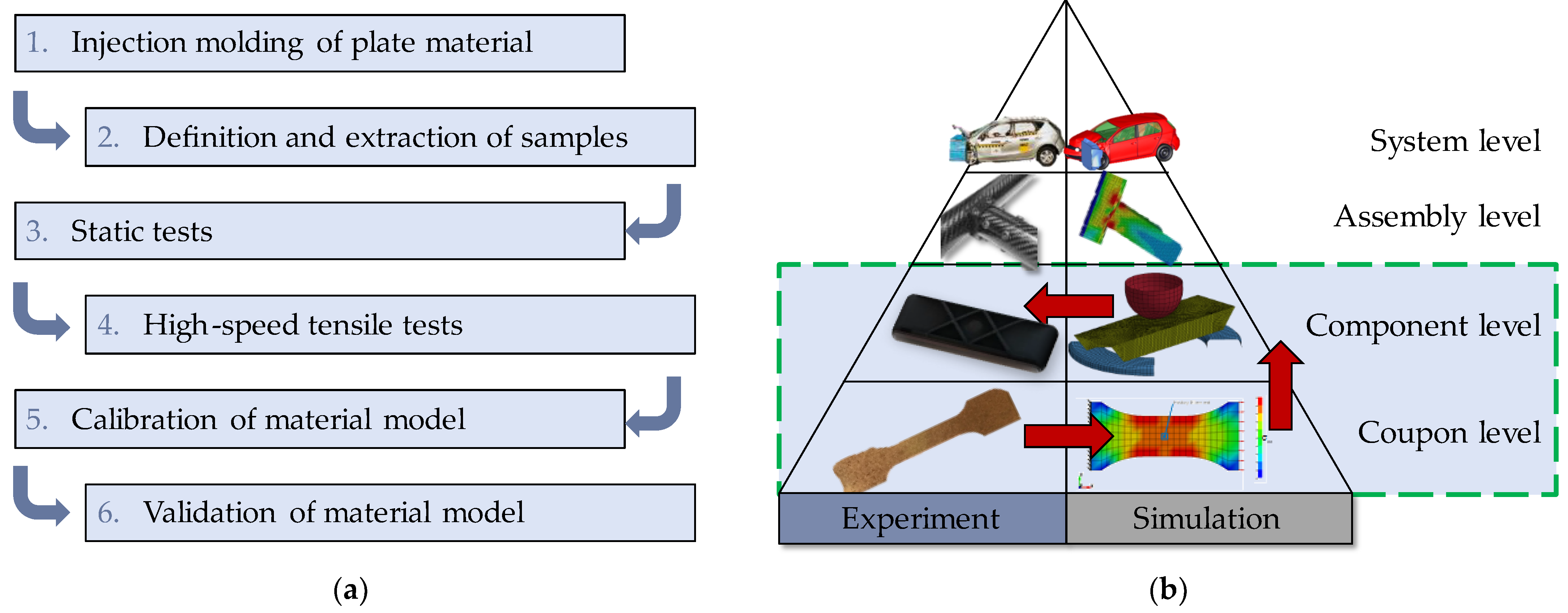

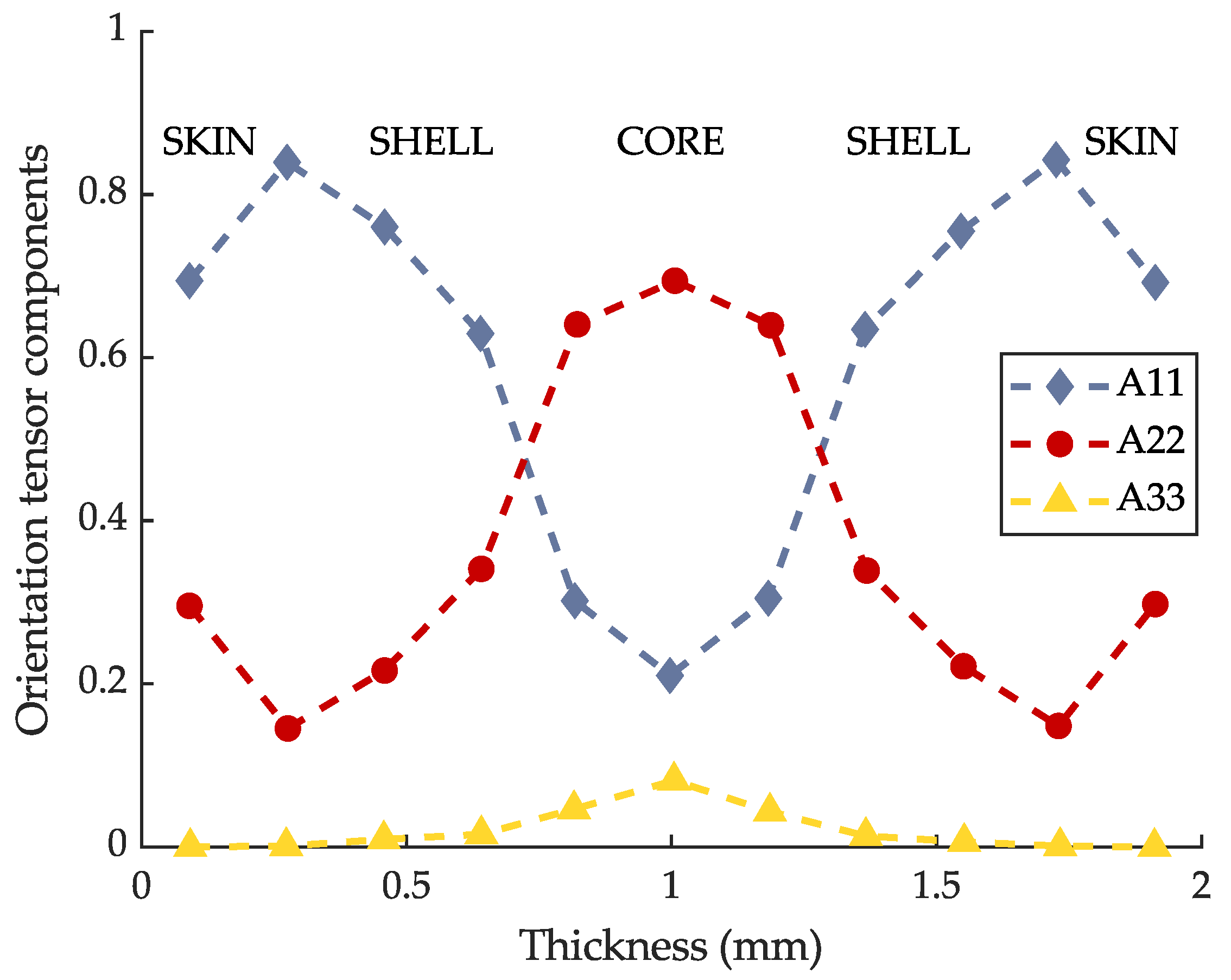
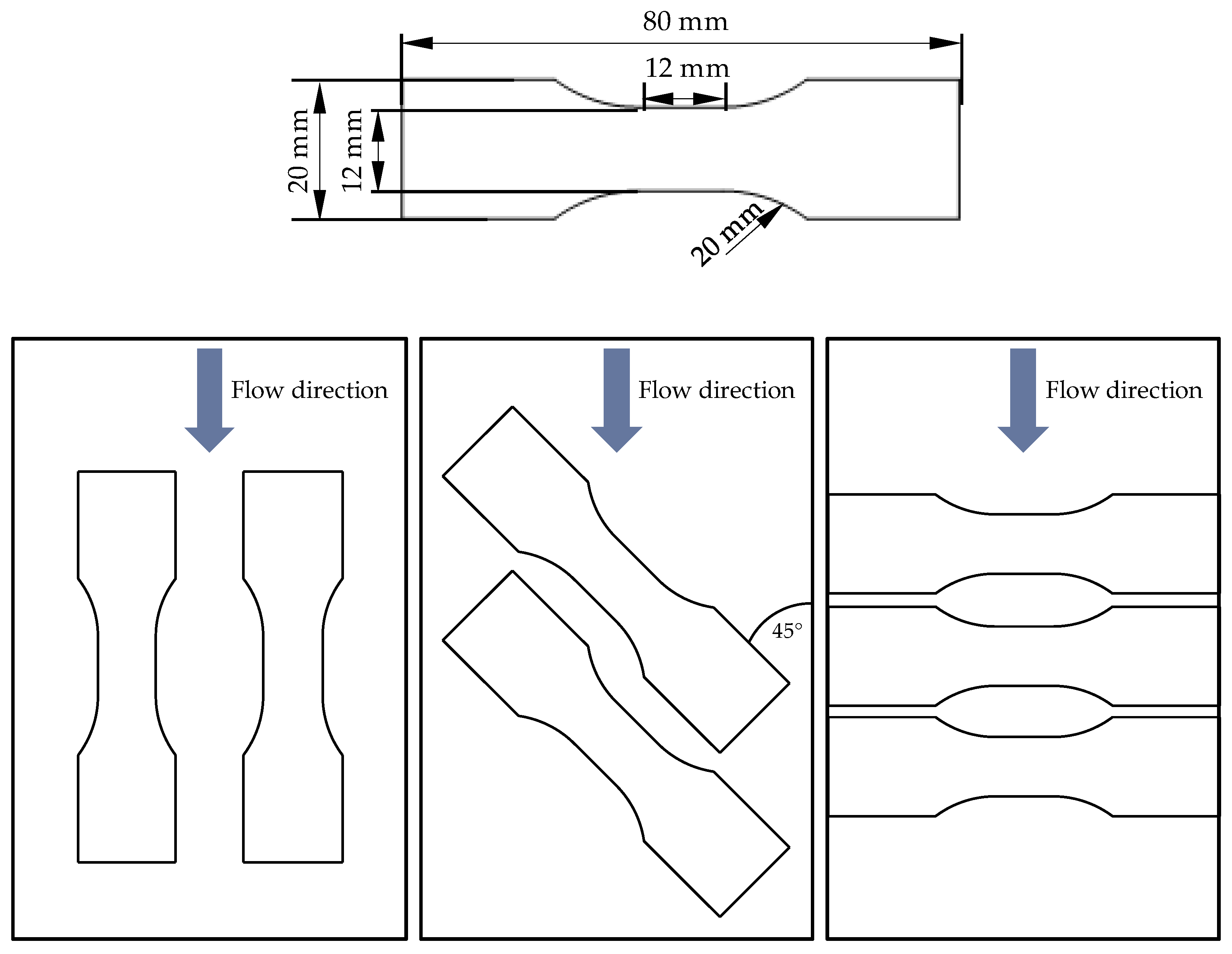
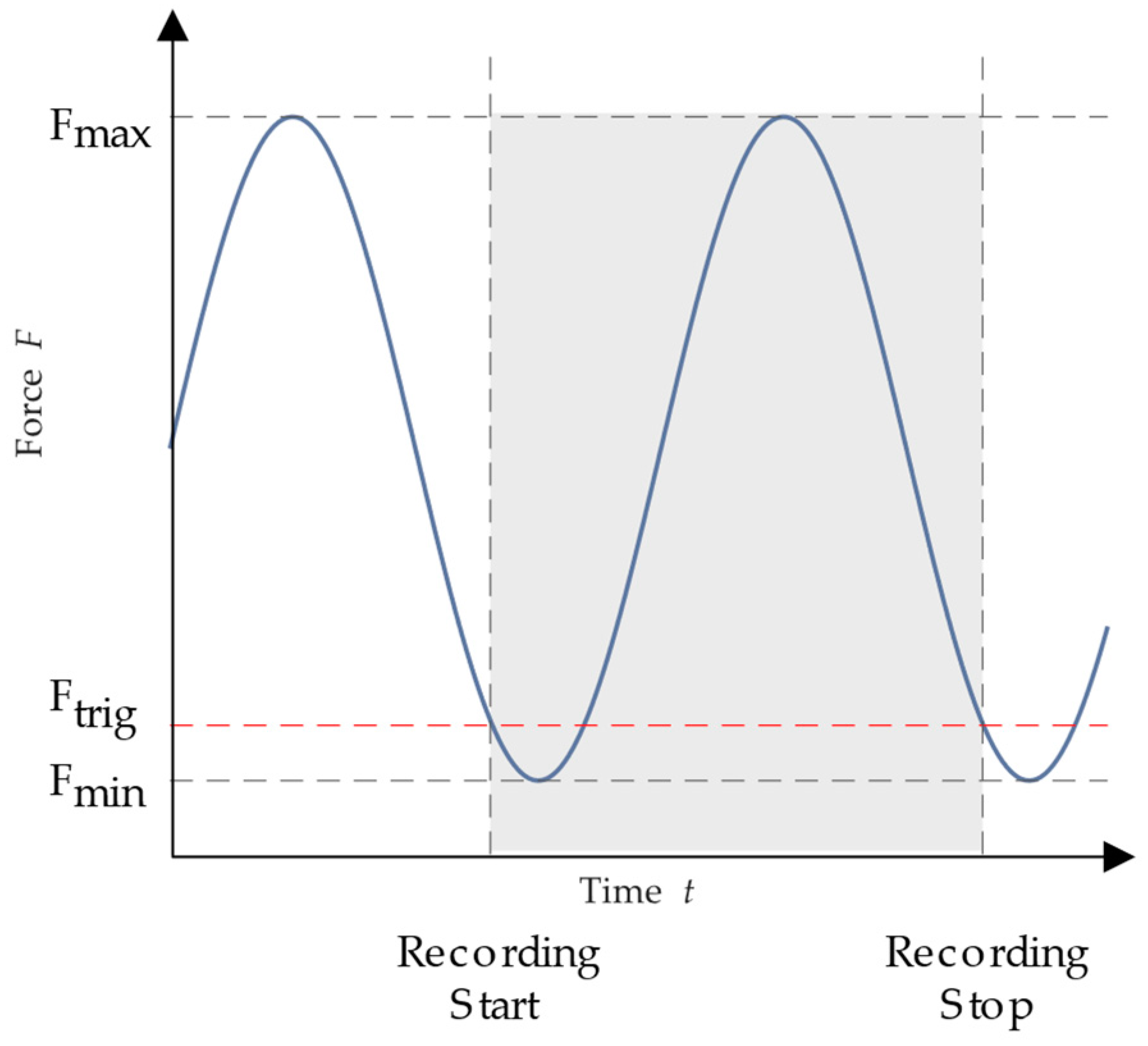
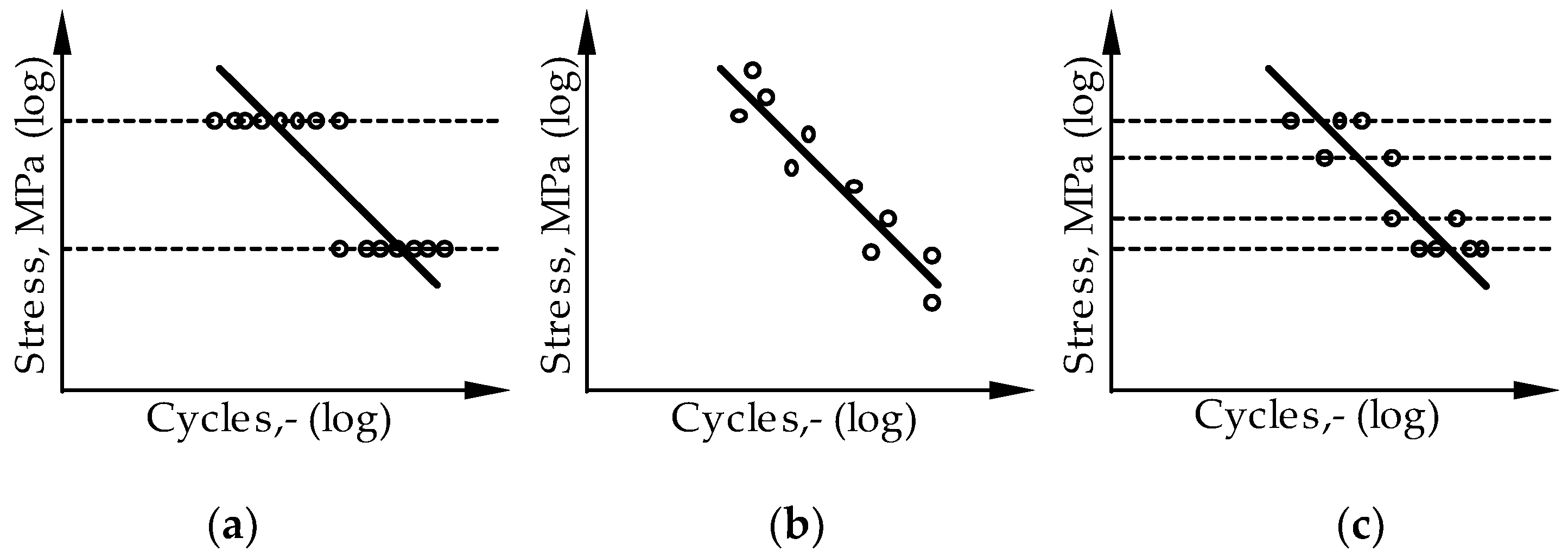

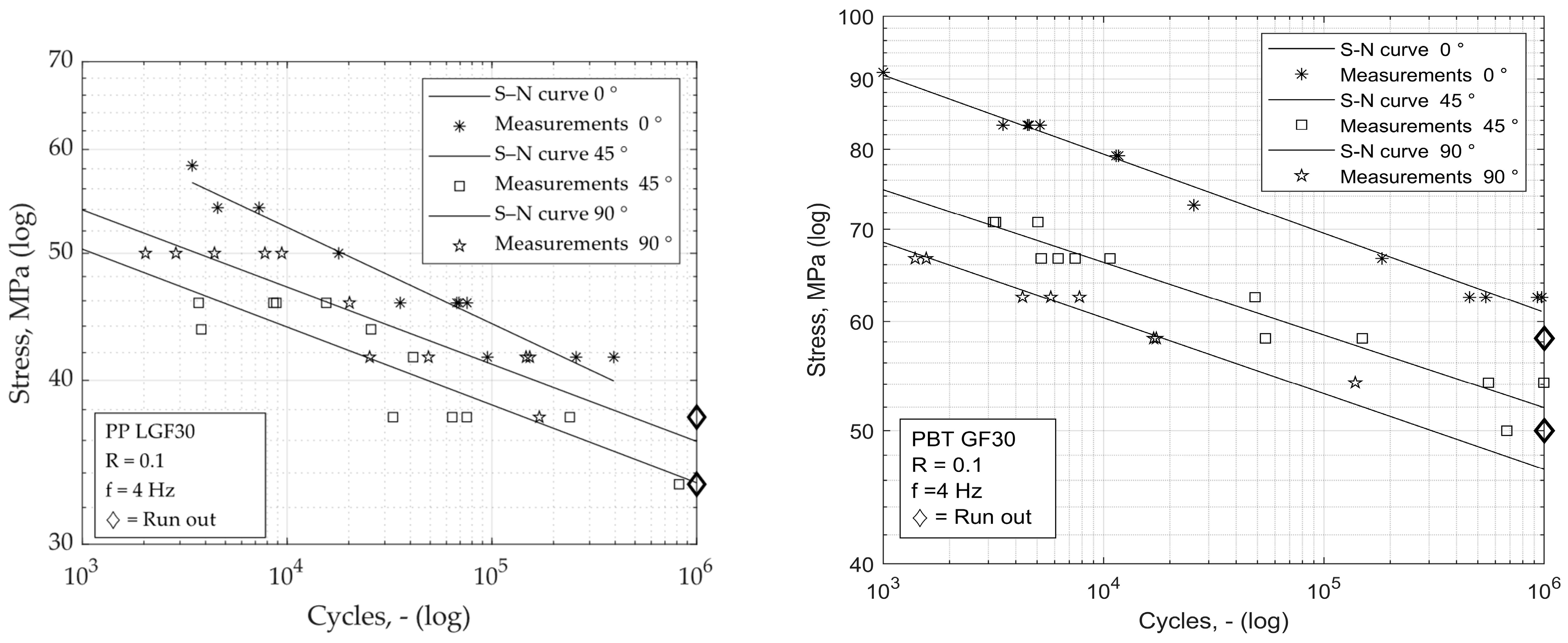
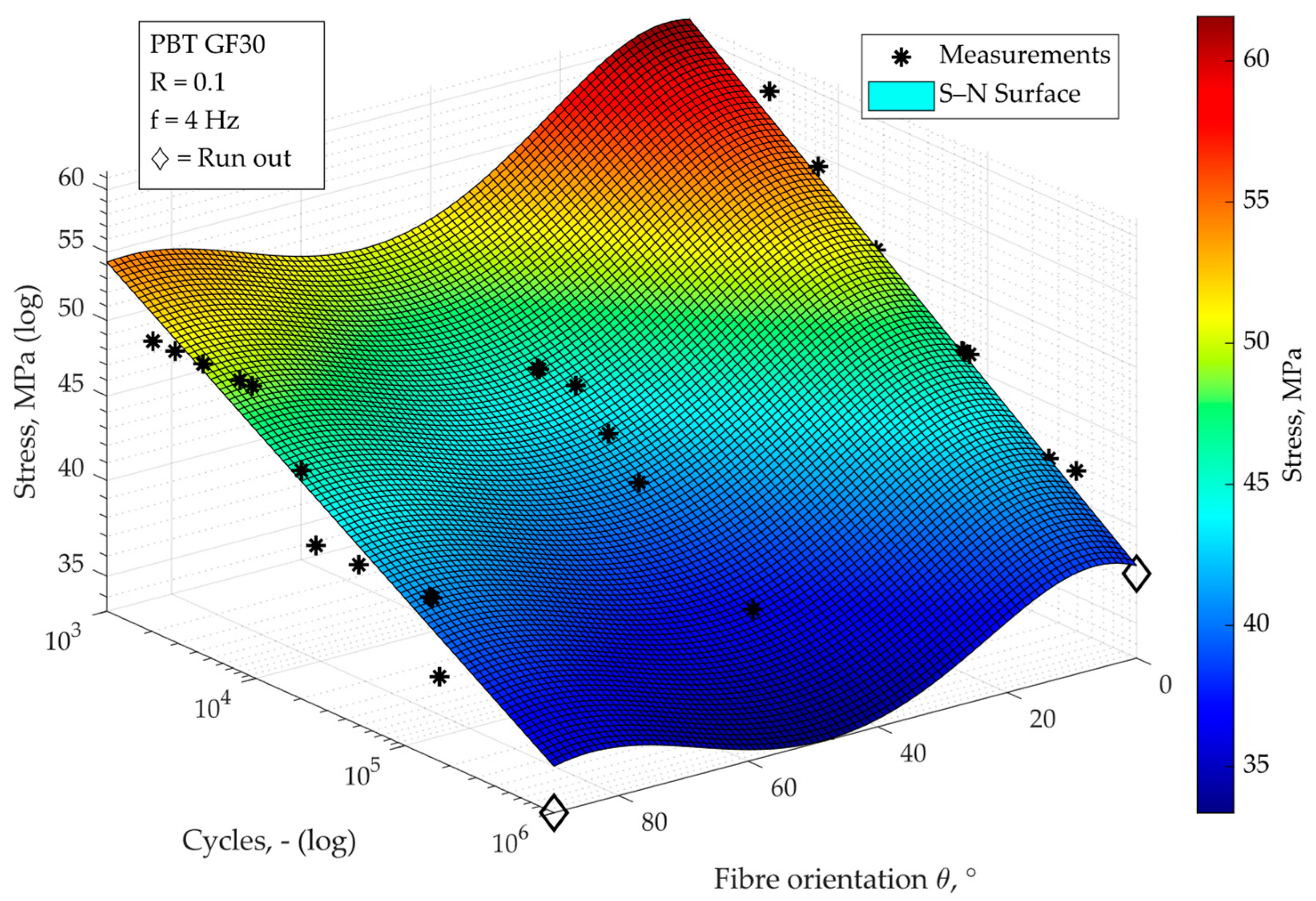


| MPa | MPa | - | MPa |
|---|---|---|---|
| 5124 | 5352 | 0.31 | 1587 |
| Parameter | Value | 95% Confidence Interval |
|---|---|---|
| , MPa | 99.2 | 83.6–114.9 |
| , MPa | 82.7 | 70.3–95.1 |
| , MPa | 43.0 | 31.8–54.1 |
| −2.8 × 10−6 | −1.4 × 10−5–8.3 × 10−6 | |
| 3.5 × 10−4 | −6.8 × 10−4–1.4 × 10−3 | |
| −7.0 × 10−2 | −8.5 × 10−2–−5.5 × 10−2 |
| Orientation, ° | Stress, MPa | Cycles | Damage |
|---|---|---|---|
| 90 | 50 | 1500 | 0.165 |
| 90 | 50 | 2500 | 0.351 |
| 45 | 45.8 | 2500 | 0.223 |
| 45 | 45.8 | 3500 | 0.232 |
| 45 | 41.7 | 3400 | 0.080 |
| 0 | 41.7 | 100,000 | 0.248 |
| 0 | 41.7 | 150,000 | 0.292 |
Disclaimer/Publisher’s Note: The statements, opinions and data contained in all publications are solely those of the individual author(s) and contributor(s) and not of MDPI and/or the editor(s). MDPI and/or the editor(s) disclaim responsibility for any injury to people or property resulting from any ideas, methods, instructions or products referred to in the content. |
© 2023 by the authors. Licensee MDPI, Basel, Switzerland. This article is an open access article distributed under the terms and conditions of the Creative Commons Attribution (CC BY) license (https://creativecommons.org/licenses/by/4.0/).
Share and Cite
Witzgall, C.; Gadinger, M.; Wartzack, S. Fatigue Behaviour and Its Effect on the Residual Strength of Long-Fibre-Reinforced Thermoplastic PP LGF30. Materials 2023, 16, 6174. https://doi.org/10.3390/ma16186174
Witzgall C, Gadinger M, Wartzack S. Fatigue Behaviour and Its Effect on the Residual Strength of Long-Fibre-Reinforced Thermoplastic PP LGF30. Materials. 2023; 16(18):6174. https://doi.org/10.3390/ma16186174
Chicago/Turabian StyleWitzgall, Christian, Marc Gadinger, and Sandro Wartzack. 2023. "Fatigue Behaviour and Its Effect on the Residual Strength of Long-Fibre-Reinforced Thermoplastic PP LGF30" Materials 16, no. 18: 6174. https://doi.org/10.3390/ma16186174
APA StyleWitzgall, C., Gadinger, M., & Wartzack, S. (2023). Fatigue Behaviour and Its Effect on the Residual Strength of Long-Fibre-Reinforced Thermoplastic PP LGF30. Materials, 16(18), 6174. https://doi.org/10.3390/ma16186174






